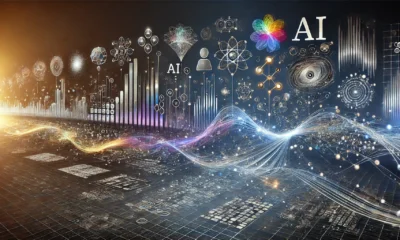Artificial Intelligence
Liquid Neural Networks: Definition, Applications, & Challenges

A neural network (NN) is a machine learning algorithm that imitates the human brain's structure and operational capabilities to recognize patterns from training data. Through its network of interconnected artificial neurons that process and transmit information, neural networks can perform complex tasks such as Facial Recognition, Natural Language Understanding, and predictive analysis without human assistance.
Despite being a powerful AI tool, neural networks have certain limitations, such as:
- They require a substantial amount of labeled training data.
- They process data non-sequentially, making them inefficient at handling real-time data.
Therefore, a group of researchers at MIT’s Computer Science and Artificial Intelligence Laboratory (CSAIL) introduced “Liquid Neural Networks or LNNs – a type of neural network that learns on the job, not only during the training phase.”
Let’s explore LNNs in detail below.
What Are Liquid Neural Networks (LNNs)? – A Deep Dive
A Liquid Neural Network is a time-continuous Recurrent Neural Network (RNN) that processes data sequentially, keeps the memory of past inputs, adjusts its behaviors based on new inputs, and can handle variable-length inputs to enhance the task-understanding capabilities of NNs.
LNN architecture differs from traditional neural networks due to its ability to process continuous or time series data effectively. If new data is available, LNNs can change the number of neurons and connections per layer.
The pioneers of Liquid Neural Network, Ramin Hasani, Mathias Lechner, and others have taken inspiration from the microscopic nematode C.elegans, a 1 mm long worm with an exhaustively structured nervous system, allowing it to perform complex tasks such as finding food, sleeping, and learning from surroundings.
“It only has 302 neurons in its nervous system,” says Hasani, “yet it can generate unexpectedly complex dynamics.”
LNNs mimic the interlinked electrical connections or impulses of the worm to predict network behavior over time. The network expresses the system state at any given moment. This is a departure from the traditional NN approach that presents the system state at a specific time.
Hence, Liquid Neural Networks have two key features:
- Dynamic architecture: Its neurons are more expressive than the neurons of a regular neural network, making LNNs more interpretable. They can handle real-time sequential data effectively.
- Continual learning & adaptability: LNNs adapt to changing data even after training, mimicking the brain of living organisms more accurately compared to traditional NNs that stop learning new information after the model training phase. Hence, LNNs don’t require vast amounts of labeled training data to generate accurate results.
Since LLM neurons offer rich connections that can express more information, they are smaller in size compared to regular NNs. Hence, it becomes easier for researchers to explain how an LNN reached a decision. Also, a smaller model size and lesser computations can make them scalable at the enterprise level. Moreover, these networks are more resilient towards noise and disturbance in the input signal, compared to NNs.
3 Major Use Cases of Liquid Neural Networks

Liquid Neural Networks shine in use cases that involve continuous sequential data, such as:
1. Time Series Data Processing & Forecasting
Researchers face several challenges while modeling time series data, including temporal dependencies, non-stationarity, and noise in the time series data.
Liquid Neural Networks are purpose-built for time series data processing and prediction. According to Hasani, time series data is crucial and ubiquitous to understanding the world correctly. “The real world is all about sequences. Even our perception —- you’re not perceiving images, you’re perceiving sequences of images,” he says.
2. Image & Video Processing
LNNs can perform image-processing and vision-based tasks, such as object tracking, image segmentation, and recognition. Their dynamic nature allows them to continuously improve based on environmental complexity, patterns, and temporal dynamics.
For instance, researchers at MIT found that drones can be guided by a small 20,000-parameter LNN model that performs better in navigating previously unseen environments than other neural networks. These excellent navigational capabilities can be used in building more accurate autonomous vehicles.
3. Natural Language Understanding
Due to their adaptability, real-time learning capabilities, and dynamic topology, Liquid Neural Networks are very good at understanding long Natural Language text sequences.
Consider sentiment analysis, an NLP task that aims to understand the underlying emotion behind text. LNNs’ ability to learn from real-time data helps them analyze the evolving dialect and new phrases allowing for more accurate sentiment analysis. Similar capabilities can prove helpful in machine translation as well.
Constraints & Challenges of Liquid Neural Networks

Although Liquid Neural Networks have edged out the traditional neural networks that were inflexible, working on fixed patterns and context-independent. But they have some constraints and challenges as well.
1. Vanishing Gradient Problem
Like other time-continuous models, LNNs can experience the vanishing gradient problem when trained with gradient descent. In deep neural networks, the vanishing gradient problem occurs when the gradients used to update the weights of neural networks become extremely small. This issue prevents neural networks from reaching the optimum weights. This can limit their ability to learn long-term dependencies effectively.
2. Parameter Tuning
Like other neural networks, LNNs also involve the challenge of parameter tuning. Parameter tuning is time-consuming and costly for Liquid Neural Networks. LNNs have multiple parameters, including choice of ODE (Ordinary Differential Equations) solver, regularization parameters, and network architecture, which must be adjusted to achieve the best performance.
Finding suitable parameter settings often requires an iterative process, which takes time. If the parameter tuning is inefficient or not correctly done, it can result in suboptimal network response and reduced performance. However, researchers are trying to overcome this problem by figuring out how fewer neurons are required to perform a particular task.
3. Lack of Literature
Liquid Neural Networks have limited literature on implementation, application, and benefits. Limited research makes understanding LNNs' maximum potential and limitations challenging. They are less widely recognized than Convolutional Neural Networks (CNNs), RNNs, or transformer architecture. Researchers are still experimenting with its potential use cases.
Neural networks have evolved from MLP (Multi-Layer Perceptron) to Liquid Neural Networks. LNNs are more dynamic, adaptive, efficient, and robust than traditional neural networks and have many potential use cases.
We build on the shoulder of giants; as AI continues to evolve rapidly, we will see new state-of-the-art techniques that address the challenges and constraints of current techniques with added benefits.
For more AI-related content, visit unite.ai












